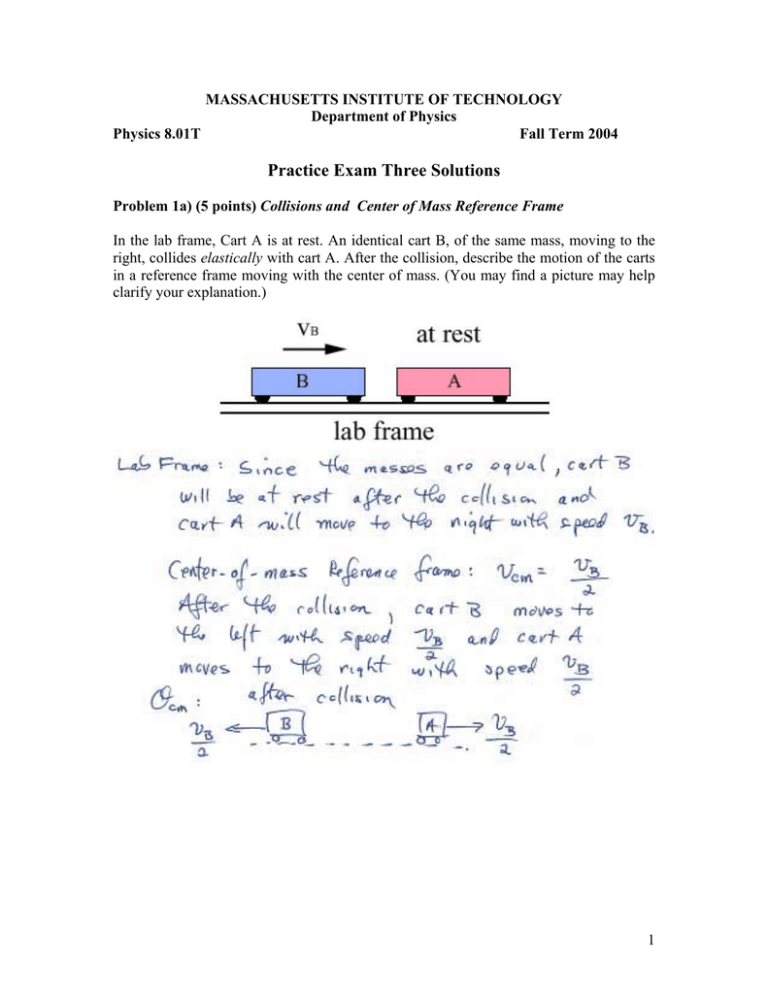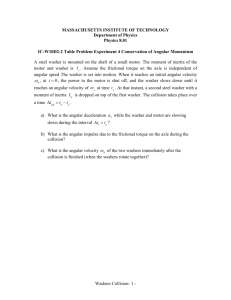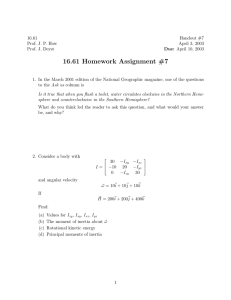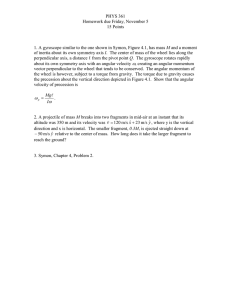Practice Exam Three Solutions
advertisement

MASSACHUSETTS INSTITUTE OF TECHNOLOGY Department of Physics Physics 8.01T Fall Term 2004 Practice Exam Three Solutions Problem 1a) (5 points) Collisions and Center of Mass Reference Frame In the lab frame, Cart A is at rest. An identical cart B, of the same mass, moving to the right, collides elastically with cart A. After the collision, describe the motion of the carts in a reference frame moving with the center of mass. (You may find a picture may help clarify your explanation.) 1 Problem 1b) (5 points) Collisions r An object P has an initial velocity v . It strikes an initially stationary object Q which is attached to a massless spring, as shown. Assume that the masses of P and Q are equal. At the point of maximum compression of the spring, is the momentum of Q greater, equal, or less than the initial momentum of P . Explain your reasoning. 2 Problem 1c) (5 points) Torque and Moment of Inertia Two wheels with fixed hubs, each having a mass of 1kg , start from rest, and forces are applied: F1 = 1N to the first wheel and F2 to the second wheel, as shown. Assume the hubs and spokes are massless, so that the moment of inertia about the center of mass is I cm = mR 2 . How large must the force F2 be in order to impart identical angular accelerations on each wheel? Explain how you arrived at your result. 3 Problem 1d) (5 points) Angular Momentum and Rotational Energy A figure skater stands on one spot on the ice (assumed frictionless) and spins around with her arms extended. When she pulls in her arms, she reduces her moment of inertia about the spin axis passing through her center of mass and her angular speed increases so that her angular momentum is conserved. Compared to her initial rotational kinetic energy, her rotational kinetic energy after she has pulled in her arms must be 1. the same. 2. larger because she's rotating faster. 3. smaller because her moment of inertia is smaller. Explain your reasoning. 4 Problem 1e) (5 points) Rolling without slipping A bicycle tire rolls without slipping across the ground (moving to the left in the figure below). Describe the direction and magnitude of the velocity at each of the four points shown in the figure as seen from an observer at rest on the ground. 5 Problem 2: Exploding Puck A hockey player shoots a “trick” hockey puck along the ice towards the center of the goal from a position d directly in front of the goal. The initial speed of the puck is v0 and the puck has a mass m . Half way to the goal the puck explodes into two fragments. One piece of mass m1 = ( 3 5 ) m comes back towards the player and passes 3d 8 to the side of the spot it was initially shot from with a speed v1, f = ( 5 12 ) v0 . The other piece of the puck with mass m2 = ( 2 5 ) m continues on towards the goal with a speed v2, f . Assume that there is no friction as the puck slides along the ice and that the mass of explosive in the puck is negligible. a) Write down the equations for conservation of momentum of the puck and fragments in terms of the quantities shown in the figure above. b) By what distance, y , does the piece that continues towards the goal miss the center of the goal? Express your answer in terms of d . 6 7 Problem 3: Torque, Rotation and Translation A Yo-Yo of mass m has an axle of radius b and a spool of radius R . It’s moment of inertia can be taken to be I = (1 2 ) mR 2 and the thickness of the string can be neglected. The Yo-Yo is released from rest. a) What is the tension in the cord as the Yo-Yo descends? b) Use conservation of energy to find the angular velocity of the Yo-Yo when it reaches the bottom of the string. c) What happens to the Yo-Yo at the bottom of the string? 8 9 10 11 Problem 4: Rolling Cylinder A solid cylinder of mass m and radius R is initially thrown along a wooden floor hallway with an initial speed v0 and zero initial angular velocity ω0 = 0 as shown in the figure below. a) What is the moment of inertia of the cylinder about the axis of rotation of the cylinder? b) What effects does friction have on the cylinder before it reaches its final speed? Is the friction static or kinetic? Which direction does it point? c) What is the angular speed, ω f , of the cylinder when it just starts to roll without slipping? Express your answer in terms of m , R , and v0 . 12 13 14 15 Problem 5: Experiment 7: Physical Pendulum A physical pendulum consists of a rod of mass m1 pivoted at one end. The rod has length l1 and moment of inertia I1 about the pivot point. A disc of mass m2 and radius r2 with moment of inertia I cm about it’s center of mass, is rigidly attached a distance l2 from the pivot point. The pendulum is initially displaced to an angle θ 0 and then released from rest. a) What is the moment of inertia of the physical pendulum about the pivot point? b) What is the angular acceleration of the pendulum about the pivot point? c) What is the angular velocity of the pendulum when the pendulum is at the bottom of it’s swing? d) If the disc is moved further from the pivot, will the period of the pendulum increase or decrease or stay the same? 16 17 18 19 Problem 6: Experiment 11 Angular Momentum A steel washer, is mounted on the shaft of a small motor. The moment of inertia of the motor and washer is I 0 . Assume that the frictional torque on the axle remains the same throughout the slowing down. The washer is set into motion. When it reaches an initial angular velocity ω0 , at t = 0 , the power to the motor is shut off, and the washer slows down until it reaches an angular velocity of ωb at time tb . At that instant, a second steel washer with a moment of inertia I w is dropped on top of the first washer. Assume that the second washer is only in contact with the first washer. The collision takes place over a time ∆t = ta − tb . Assume the frictional torque on the axle remains the same. The two washers continue to slow down until at they stop at t f . a) Describe how you measured the moment of inertia in the experiment. A torque was applied to the rotor by a string that was supporting a weight. When the weight was dropped, the rotor began to accelerate. The acceleration was measured by making a straight line fit to the voltage vs. time graph, and then using the calibration factor for turning voltage into angular frequency. Once the string unwound, the frictional deceleration was measured in a similar fashion. The rotational dynamics for the two stages are given by RT − τ f = Iα up −τ f = Iα down Note that α down < 0 The first two equations above imply that RT + Iα down = Iα up . The force equation for the first stage is given by mg − T = maup . The linear acceleration and angular acceleration are constrained by aup = Rα up . Combining these last two equations and solving for the tension yields 20 T = mg − mα Rup Substituting the tension into the combined torque equation yields mg − mα Rup + Iα down = Iα up We can solve this for the moment of inertia I= mgR − mα Rup α up − α down = mgR − mα Rup α up + α down b) What is the angular deceleration while the first washer and motor is slowing down? c) What is the angular velocity of the two washers immediately after the collision is finished? d) What is the angular deceleration after the collision? 21 22







